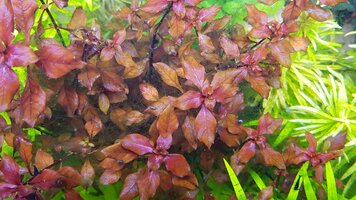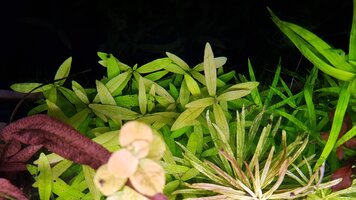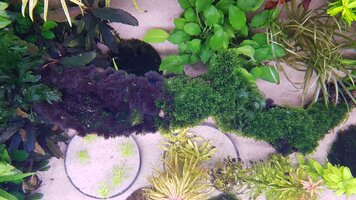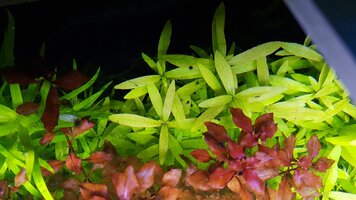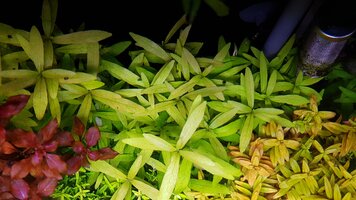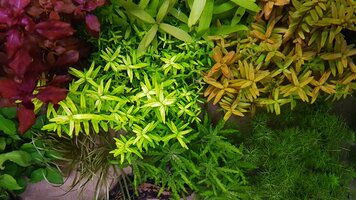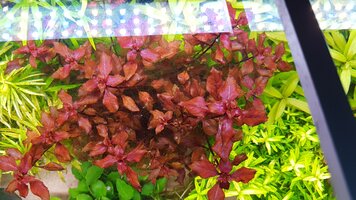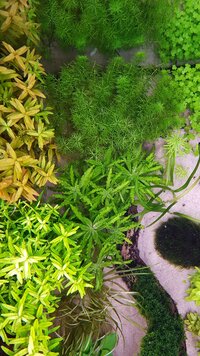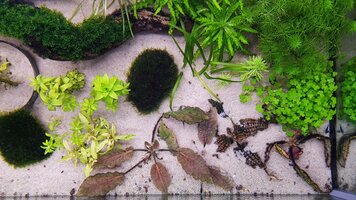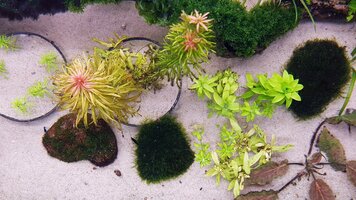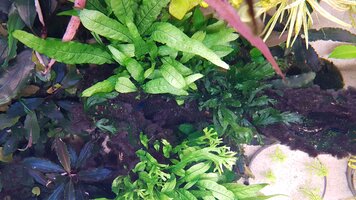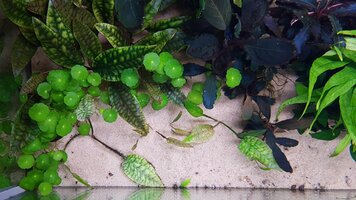I took lotsa photos for you guys today, hold on to your hats 🤠
It will be nice to have a proper baseline of plant photos to compare things to again, the past few months have been a little bit spotty in documentation 🤭 and that made it hard to get a good idea of what was going on. Its not like I can remember any of it 🥴

Ive done a fair bit of trimming since I came home, so things might not look super lush at the moment, but a few plants really needed it.
Also moved a few plants around, im slowly starting to regain some open space in the tank, and it feels really good, and looks so much better than having something in every single available area.
Ive brutally removed loads of huge leaves from the Spiralis Red, I sort of knew this was one of the bigger crypt species, but I guess I failed to realize exactly how big.
I want to see if I can make it slightly less happy by removing some leaves and see if it will put out some medium sized ones. Worth a try anyway eh.
This kind of thing is really a luxury problem of CO2-injected tanks, suddenly some plants are
VERY happy and youre wondering if you could make them a little bit less happy/vigorous while still maintaining good form.
Im having a problem of the same sort with Sagittaria subulata, its very easy going and thinks conditions are pretty sweet regardless of the minor issues that bother some of the drama queen stems.
I have somehow triggered it to convert to the tall growing form, and in addition to growing leaves that are much longer than I would like, it sends naughty runners absolutely everywhere and its a fair bit of work sussing them out and removing them before the runners have already had runners of their own and suddenly Sag is appearing halfway across the tank and how did you even get there!?
I pulled out the whole bunch yesterday, kept only a few rosettes which I trimmed the roots short on (hoping they will be sad and stay there for just a little while), and im also hoping I can persuade them somehow to be short again. Ive seen two reasons cited as the cause of this change in length, one is crowding and one is light.
When they started putting out long leaves they were crammed in tightly on the left side of the tank and partially shaded by some epiphytes, so thats 2/2 I guess.
Having moved to the right side, they now get lots of light, but the long leaves continue to come.
So sparse group it is. If that doesnt work I will try replanting the group with only runners, and throw away the original rosettes, but I dont think it will work.
Its a really nice little plant though, it has a wide grassy texture which is a bit lacking in my tank, and a very nice solid lime green color that contrasts well with other green plants.
My SO likes it as well, which you all probably know gives the thing in question an automatic +1 bonus point
😉
Maybe I can bury a small cup in the area and that will keep those pesky runners inside the group.. 🤔
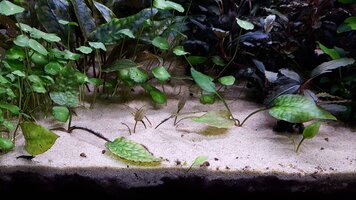
The left hand crypt corner isnt quite as crazy as the right one, but the "Queen Vandom" has still been quite busy, as I now suddenly have three daughter plants.
She seems to be prioritizing propagation over growth, right now she only has three leaves but its possible I accidentally broke the fourth off the other day while I was pulling out Hydrocotyle verticillata

I think the latter might do better on the right side of the tank, its a bit leggy due to the light and I constantly have to trim it back to make sure it doesnt infringe on my precious crypts.
In the center of the picture you can see Cryptocoryne ferruginea, I bought one plant but the leaves gradually wilted on the main plant and three shoots came up instead. The growth has been very slow so far, but the starting plant mass was super small and I think it is still establishing itself. Only time will tell if it will stay this slow.
Crypts are really starting to grow on me, I find it ironic as I shied away from this family for so many years thinking they wouldnt like me very much

But now theres babies and spathes and fruits all over the place 😄
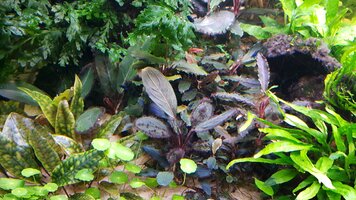
Buce "corner", biggest leaf in the center is the Dark Achilles, which is really putting on mass. Many of the Buces sulked for a while back when I was trying to trim off leaves with BBA, but have slowly recovered now that I let them grow undisturbed. In the back left you can sort of see Silver Grey and Pearl Grey who has also put out some very large leaves.
My experience so far is that its not a good idea to trim Buce leaves unless youre really really sure that algae is no longer growing in the tank.
Otherwise your trimming will soon outpace the Buces growth and the plant will suffer for it.
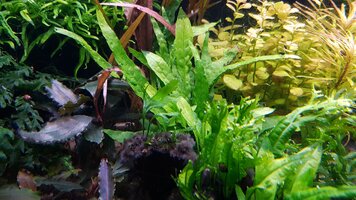
Bolbitis Type B is doing really good, theres only two rhizomes left, the other ones didnt make it through my unkind welcoming treatment.
There were three rhizomes but I accidentally pulled one loose trying to grab some thread algae a while ago, and the third has been sitting forgotten in a cup in the kitchen somewhere, waiting forever for me to bother gluing it back on again

But the two in the tank are doing well and putting out leaves like champions

Bolbitis Type A still doing great;

As you can see the BBA is back again for now, I wonder what caused it to die off earlier?
Ill have a rummage through the journal, see if I can discern anything.
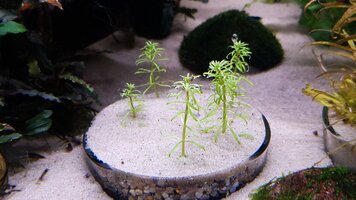
Second cup of Aquasoil, with five baby Pantanal stems from the windowsill.
Let the Anger Games begin
🙄
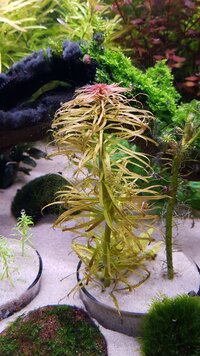
The stem that hit the surface and got replanted is, unsurprisingly to anyone, really angry now.
The plant width / leaf length is possibly the best width ive had on Pantanal so far, so that is pretty nice.
I feel like its slowly inching closer and closer to something decent.
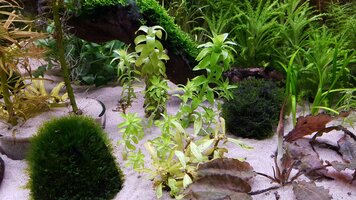
Tonina is happier and decently green, the long stalk got divided today and got a few friends from the windowsill.
Not bothering with Aquasoil for this, Tonina doesnt seem to care much and hardly puts out roots anyway.
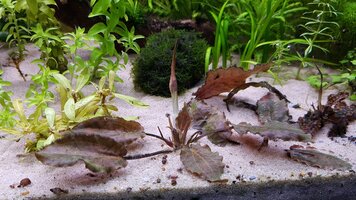
Second spathe of Yujii, not opened yet but seems like this also will open towards the back
 🙄
🙄
The mossy rock in the background is the "Troll Moss" that I found in some local stream, and aside from a bit of BBA its growing really well.
I have a bunch more of it propagating in the kitchen, planning to send some over to the UK when I get the chance

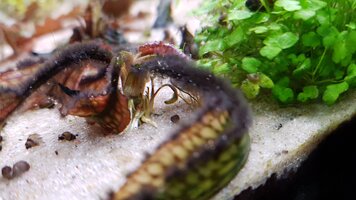
The Cryptocoryne striolata "Tiger" is up to something, it has what looks like tiny offshoots around its base, theres two on this side in the picture and another one obscured by a leaf.
Call me crazy but I think it might be making a few more Tigers for me
😳

Seed pods / fruits on Striolata Mini are still closed, and when I poked the oldest one it felt very firm and not dead still, so im just leaving them and seeing what happens.
They are the two dark blobs in the picture, the brighter thing between them is the remnant of an old spathe, I think ive lost count on how many it has put out now, the spathe its currently sending out might be number 5, and I see another tail coming up to the left

Stargrass is the greenest I think ive had it in a long time, I think we're really close to a chlorosis-free tank!

Cuba is a bit pale but it grows a lot slower than the Stargrass, so I think it will come around, might need just a touch more iron to make everyone happy.

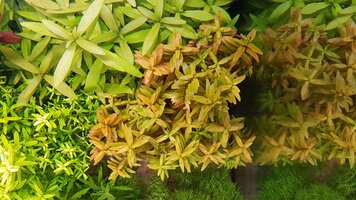
Rotala rotundifolia "Orange Juice" is looking really beautiful, getting very close to how I want it to look now.
I have been gradually* increasing the light output of both Fluvals, and the OJ has responded in kind.
(*Hufsa-Gradually, not to be confused with ordinary gradually)
Is increasing the light a good idea when youre struggling with green thread algae? Absolutely not. Am I doing it anyway? You bet I am!
It reminds me of a doctor I used to go to, he had a sign hanging prominently in his office that looked like this;

Contrary to what you might believe he was actually a great doctor

So im increasing the light intensity because I have the irresistible urge to do stupid things faster with more energy 😁
Its like trying to repair your car engine while accelerating wildly down the highway

Yeehaw!
























 I think the latter might do better on the right side of the tank, its a bit leggy due to the light and I constantly have to trim it back to make sure it doesnt infringe on my precious crypts.
I think the latter might do better on the right side of the tank, its a bit leggy due to the light and I constantly have to trim it back to make sure it doesnt infringe on my precious crypts.














